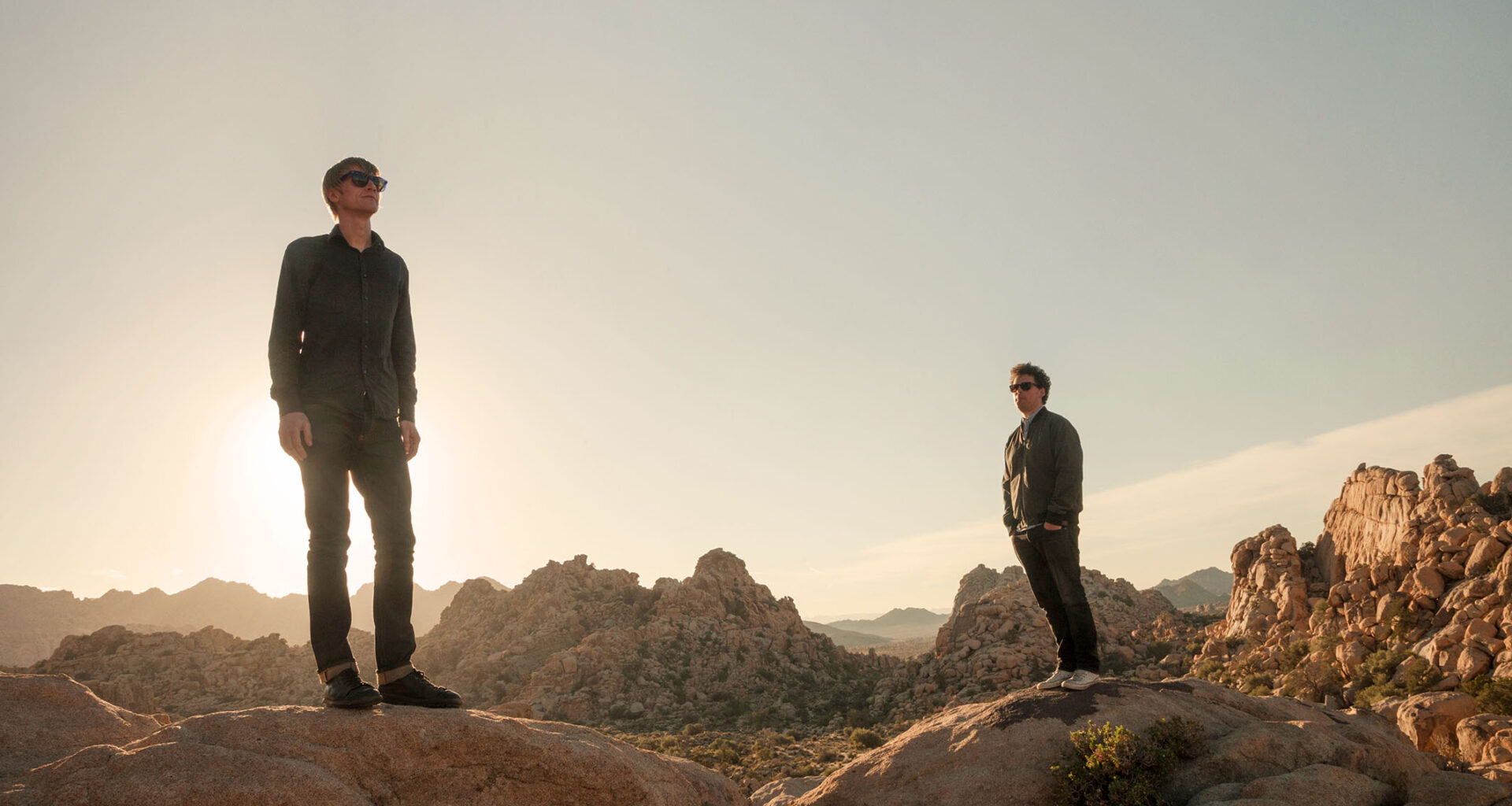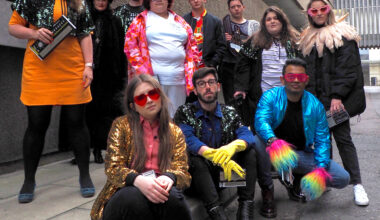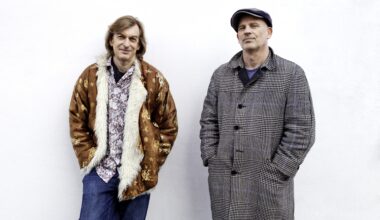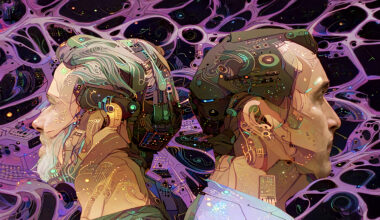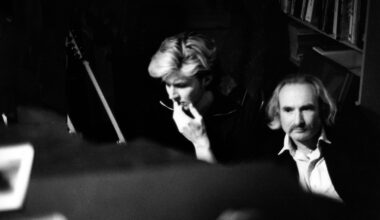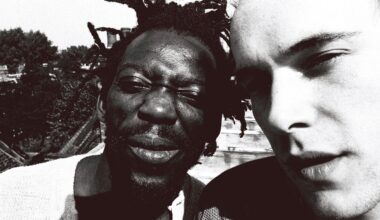The ever-inventive Simian Mobile Disco make a welcome return with a new long-player and this time they’ve gone all ambient. In a desert. With bikers
The Joshua Tree National Park lies in southern California at the crossing place between the Mojave and Colorado deserts. It’s the postcard essence of the untamed American frontier. Wild, desolate and lifeless, it’s a place full of otherworldly skies, native Joshua trees, bizarre cacti and rock formations sculpted by millions of years of erosion. As natural environments go, it is astounding and weirdly beautiful. It’s just not a place you’d readily associate with electronic music.
On the northern edge of the park is Pioneertown, the quintessential dustbowl outpost. It was built not in the 19th century but in the 1940s, as a working film set for authentic Western shoot outs. Once the film crews moved on, regular folk started to move in and its obligatory saloon bar, Pappy & Harriet’s Pioneertown Palace, became a mecca for anyone needing to satisfy a thirst either before or after venturing into the desert. The bar was especially popular with bikers, who’d arrive on huge hogs on their way to hell (via San Bernadino), as well as with those looking to find themselves, answers, or the existence of alien life forms out among the inselbergs and twisted trees.
While Pappy & Harriet’s is now a regular stopover for any touring indie band looking to play a quirky venue in the middle of nowhere, it’s not a natural home for music made on modular synths by two politely-spoken, trendy, young electronics nerds. But that didn’t stop Simian Mobile Disco from recording their new album, ‘Whorl’, in front of a live crowd at Pappy’s and out in the desert near where the duo were staying, running an extension cable from their cabin and playing their synths while facing the rocks. The result is an evocative ambient opus every bit as strange and wonderful as the surroundings in which it was created.
“It’s a nice break from the day job,” laughs James Ford, back in London where the live recordings for ‘Whorl’ were re-assembled.
James Ford’s comment comes with a degree of irony. Simian Mobile Disco, his long–running project with Jas Shaw, was originally conceived as a fun distraction from the pair’s work in the electronic rock band Simian. Simian disbanded after two albums, the parent band overtaken by the success of Simian Mobile Disco, only for Ford’s producer credentials – what he calls his day job – to fully eclipse Simian Mobile Disco too, his name having appeared on albums by Arctic Monkeys, Florence & The Machine and Klaxons.
Beginning with 2007’s ‘Attack Sustain Decay Release’ album, Simian Mobile Disco set about offering a euphoric assault on both the feet and the eardrums. Resolutely upbeat, feel-good and infectious, ‘Attack Sustain Decay Release’ sounded like Basement Jaxx after electroshock treatment. Yet in its title – referring to the key dynamics of a soundwave – SMD revealed themselves as synth boffins who seemed to know the precise scientific combination of beats, hooks and vocals required for maximum impact. It was never intended to be a serious record, though. Not according to Ford.
“We just thought we’d make some party tunes and mess around with synths,” he shrugs, casually belittling what turned out to be a solid first effort.
The duo’s next two albums were linked more by differences more than by similarities. If ‘Attack Sustain Decay Release’ was energetic club music, its 2009 follow-up fell squarely within the environs of pop music. ‘Temporary Pleasure’ saw Ford and Shaw working with an array of singers whose work they admired – the likes of Gossip’s Beth Ditto, Yeasayer’s Chris Keating, Hot Chip’s Alexis Taylor and Super Furry Animals’ Gruff Rhys – but Ford doesn’t view the glossy fusion of dance and pop music as SMD’s most representative statement.
“I think we went a bit too headlong into the kind of collaboration thing on ‘Temporary Pleasure’,” he says. “It’s a classic producer trap to fall into. Working with a lot of talented vocalists meant their personalities often took over the tunes, while our own personalities and musical tastes sometimes got a little obscured. In retrospect, I think it holds together the least cohesively of all our albums. I think that was the learning curve for us and we haven’t done much with vocalists since. It’s not that we’re against that kind of collaboration, I just think we’re very aware that we lost a bit of ourselves in that process.”
Chris Keating has said that each Yeasayer album has effectively been a reaction to the previous one – and that was certainly the case with Simian Mobile Disco’s 2012 offering, ‘Unpatterns’. Jettisoning the collaborations, it also signalled a departure from the euphoric vibe of the first two albums, offering a more muted, even sombre mood.
“We’re definitely excited by the idea of progression and moving forwards,” says Ford. “I don’t see the point of bands trying to repeat something they’ve already done. So much depends on the circumstances and the context in which you make a record. Even if you were to get back to exactly how it was, you’d find everything has moved on by that stage anyway. To us, it seems ridiculous to try and do that.”
Listened to in chronological order, the Simian Mobile Disco albums have grown increasingly more thoughtful and considered with each release, becoming fully realised in the ambient drift of ‘Whorl’.
“We’ve always been interested in deeper, weirder, more psychedelic music,” confesses James Ford. “I also think that playing in clubs and getting into the darker side of dance music has affected our tastes. When we started, we weren’t really into straight-up club music and so we were excited by the idea of making tracks like that for ‘Attack Sustain Decay Release’. However, a lot of it is quite maximal – always reaching for higher highs – but as we went on, and especially with the bloom of a lot of EDM stuff, we ended up finding that style a bit… cheesy. We enjoy a subtler hit now.”
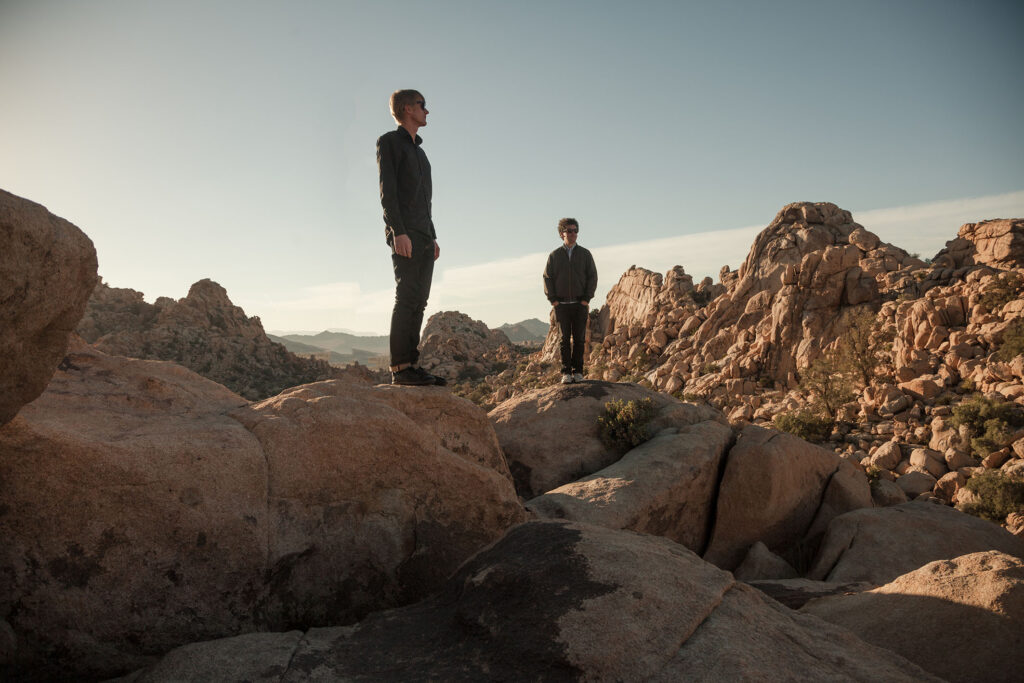
Subtle is an apt description for ‘Whorl’. The title refers to naturally occurring concentric circles in plant biology and in fingerprints. While this might link neatly back to the scientific reference encapsulated in ‘Attack Sustain Decay Release’, the science employed here is altogether more organic, more human, more elemental, more in tune with the environment in which the new SMD album was realised.
Capturing that quality was a conscious effort claims Ford, reflecting both the techniques and the systems used to record ‘Whorl’, and also a desire to pay homage to their electronic music forebears – many of who faced incredible challenges just to produce a single sound.
“I think some of that gets forgotten in a lot of electronic music these days,” he explains. “A lot of modern electronic music is made by pushing blocks around a screen. On a computer, it’s very easy to make things rigid and everything happen in fours, making it almost binary. That’s the main reason we elected not to use a computer on the new album. You’re using your hands and your ears and it’s less visual. It’s more instinctual when it comes the structures of the songs. That was the thing we were most excited about achieving on this record.”
The result is slowly-evolving, intricate music that manages to avoid sounding like two talented synth heads disappearing into a Rick Wakeman-style modular wormhole. The analogue textures, pulses and melodies – here given space to develop at their own pace – draw parallels with Flood and Ed Buller’s Node project, or Warp’s genre–defining ‘Artificial Intelligence’ compilations and artist album series. It’s undeniably ambient music, in the sense of it being interesting, atmospheric and absorbing, but mercifully there’s no magnolia sonic wallpaper here.
“Warp was one of the first electronic music bonding experiences for Jas and me,” recalls Ford wistfully. “When we were trying to get Simian together, we were really excited by the idea of trying to mix some of that with Simon Lord’s more folky type songs. Autechre, Boards Of Canada, obviously Aphex… all of that stuff was a huge influence on us. Coming from a guitar background, the first time you hear an Autechre or an Aphex record, you think ‘How the fuck did they do this?’. It doesn’t make any sense. It’s like taking a radio apart and putting it back together again just to see how it works. The excitement that comes from that is definitely a great motivator for me.”
Such deconstructionist interests explain why ‘Whorl’ sounds like it does, but SMD’s reverence for pioneering approaches to making music with technology extends further back than Warp’s early 90s experiments.
“We got very into a lot of the electronic pioneers’ stuff,” enthuses Ford. “People who had to build things before they could make music, from Raymond Scott to Delia Derbyshire. There’s loads of those people in history whose attitude to making music is inspiring to us.”
While their earlier tracks might have had the barest trace of a questing, experimental leaning, Simian Mobile Disco like the idea of treating each album as a challenge. In the case of ‘Whorl’, that challenge came not only from eschewing the use of a computer in the writing process but, to make life just that bit harder, recording the album completely live. Ford and Shaw were attracted by the California desert because it was as far away as possible – metaphorically and geographically – from where their previous albums had been recorded.
“We each had a box of modular synths, a sequencer and a mixer,” explains Ford. “We decided that we would make every single sound on the album come out of this limited system of equipment. So we spent quite a while choosing the best parts, the best sounds, and we set about learning how to use this gear, playing around with it and programming the sequencers.
“We did that in London over a period of about three weeks and then, because it was pretty portable, we thought it would be nice to take the equipment somewhere interesting. So we went out to the desert for a week, where we did more writing and rehearsals. We then did a performance near the house we were staying at. We set up in this kind of natural amphitheatre where you couldn’t really see any human life. We did one take there and then we did the gig at Pappy & Harriet’s.”
Modular synths in what is essentially a biker bar sounds like a recipe for the type of scenes that greeted Suicide when they supported Elvis Costello. Getting bottled off by disgruntled heavies wasn’t out of the question.
“A lot of people came out from LA for it, but there were some locals,” says Ford. “Joshua Tree has quite a history of strange, hippy, alien-chaser types, so we actually went down really well.”
That said, Ford does admit that the idea was not without danger.
“We were keen to put ourselves in that risky situation of trying to record something live,” he offers. “It gives you an extra energy and a little extra push to do something that you wouldn’t normally do. You can’t control all the elements because you’re making a record on the spot, so things inevitably don’t happen as you want them to, but we tried to keep as much of that on the final album as possible. Where things had a little bit of life or something unexpected happened, we wanted to keep those things in there.”
As recently as 30 years ago, electronic music had that kind of inherent danger attached to it. Synths didn’t always work, machines didn’t behave themselves, the slightest wrong touch of a dial or a fader and the result could be amazing or terrible. It made for a completely different discipline when attempting to control a modular system in a live setting.
“It’s an aesthetic decision,” agrees James Ford. “People make brilliant records with laptops and we’re not anti-technology by any means. But taking that element away and adding the limitations of real machines and the unpredictability that gives… we found that really creative and really exciting. For us, that’s enough reason to do it.
“With the modular stuff, there’s no menu and every knob or dial has a direct function, so if one sound is too long there’s a knob that changes the length of it. It’s very satisfying to play in that way, very instant. It’s as physical as playing any other instrument. We’ve had lots of comments about how it feels very alive and people can hear we’re working to control this beast of a thing, teetering right on the edge of being able to do so. I like that aspect of it. Even for people who don’t understand what we’re doing, they can still recognise that push and pull and that energy.”
All of which highlights Simian Mobile Disco’s commitment to sticking to their own agenda.
“I think what Chris Yeasayer said of their albums is definitely true of us too,” says Ford. “We’re quite contrary, quite pedantic. If something seems to be going well, we definitely want to go in the opposite direction. Right now, we’re trying to harness this modular system and it’s like a runaway train. It makes each and every show exciting. You never know exactly what’s going to happen and that’s quite nerve-racking, but it’s ultimately pretty satisfying when it goes well.”
‘Whorl’ is out on Anti Records
